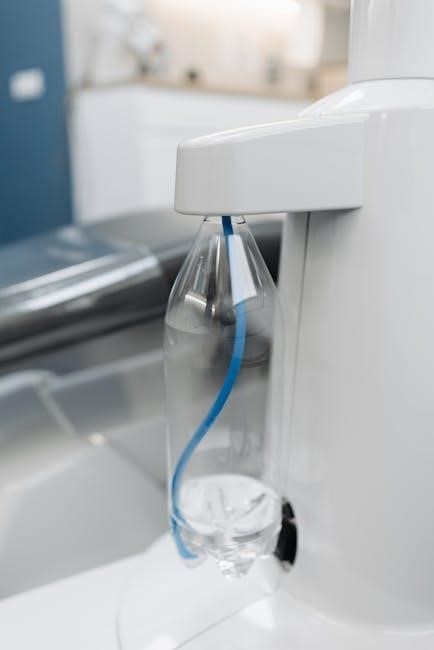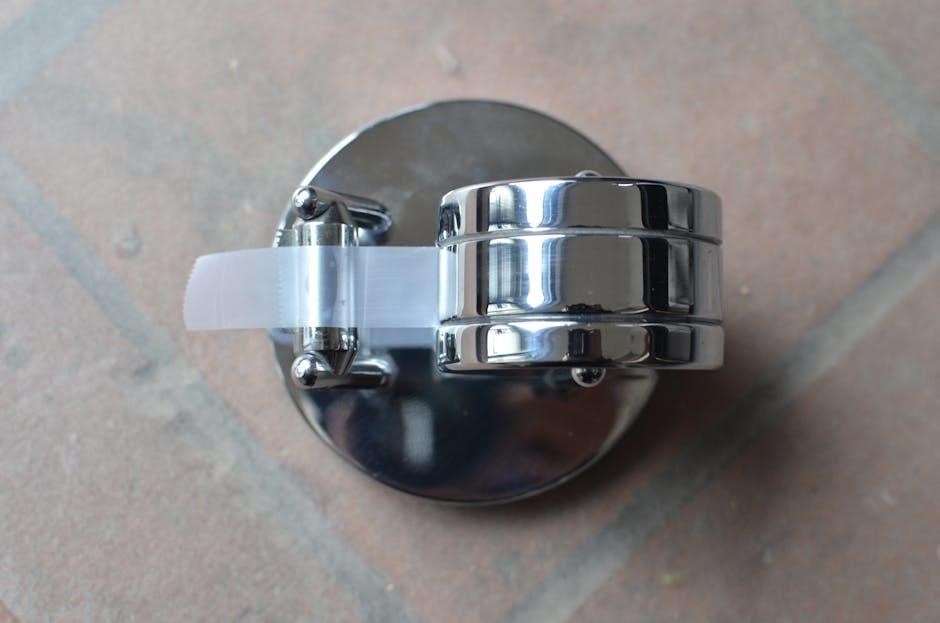A manual water dispenser is a simple, eco-friendly device designed to provide fresh drinking water without electricity. Popular in homes and offices, it offers a cost-effective, sustainable solution for accessing clean water, appealing to environmentally conscious users seeking reliability and ease of use.
What is a Manual Water Dispenser
A manual water dispenser is a device designed to dispense water from a bottle or reservoir without the need for electricity. It typically features a simple mechanism, such as a pump or lever, to release water into a glass or container. These dispensers are often used in homes, offices, or outdoor settings, offering a convenient and eco-friendly way to access fresh drinking water on demand.
How a Manual Water Dispenser Works
A manual water dispenser operates using a pump or lever to release water from a bottle or reservoir through a valve, relying on manual effort and gravity.
Components of a Manual Water Dispenser
A manual water dispenser typically consists of a water bottle, pump, valve, tubing, and a stand or frame. The pump creates suction to draw water from the bottle through the tubing into a spout or faucet. The valve controls water flow, while the stand provides stability. Durable materials like stainless steel or BPA-free plastic ensure safety and longevity. Some models include additional features like child safety locks for added convenience.
Operating Mechanism
The manual water dispenser operates by using a pump to create suction, drawing water from a bottle through tubing into a spout. Pressing the pump lever or button increases pressure inside the bottle, forcing water up and out. Releasing the lever allows the pump to return to its original position, ready for the next use. This simple, energy-free mechanism ensures consistent water flow with minimal effort required from the user.
Benefits of Using a Manual Water Dispenser
Manual water dispensers offer eco-friendly, cost-effective solutions, reducing plastic waste, while their energy efficiency and portability make them ideal for homes, offices, and outdoor use without installation.
Convenience and Space-Saving Design
Manual water dispensers are designed for convenience, often compact and lightweight, making them easy to place in small spaces. Their portability allows use in various settings like kitchens, offices, or camping. Many models feature easy-pour mechanisms, reducing spills and ensuring quick access to water. This space-saving design makes them ideal for both home and outdoor use, enhancing daily convenience without requiring installation or electricity.
Cost-Effectiveness
Manual water dispensers are budget-friendly, offering significant savings compared to automatic models. They require no electricity, reducing energy costs, and are often priced lower upfront. Maintenance is minimal, with fewer parts to replace. Their reliance on refillable water bottles also cuts down on single-use plastic expenses, making them a cost-effective, eco-conscious choice for households and offices seeking affordable hydration solutions without compromising on functionality or quality.

Installation and Setup Guide
Manual water dispensers are easy to install, requiring no complex tools or plumbing. Place the dispenser on a stable surface, attach the water bottle, and ensure all connections are secure for proper function and leak prevention.
Step-by-Step Installation Process
- Place the dispenser on a stable, flat surface.
- Remove the protective packaging from the dispenser and accessories.
- Align the water bottle with the dispenser’s inlet valve.
- Gently push the bottle into the dispenser until it clicks securely.
- Check all connections to ensure there are no leaks.
- Test the dispenser by pumping the lever or pressing the button.
- Ensure proper water flow before regular use.
Tips for Optimal Placement
Position the manual water dispenser on a stable, flat surface to prevent wobbling or spills. Place it near a power source if it has an electric pump. Ensure it’s easily accessible to all users, especially children and the elderly, for convenience. Keep it away from direct sunlight and moisture-prone areas to maintain hygiene and functionality. Proper placement enhances usability and safety, ensuring the dispenser serves its purpose effectively.
Maintenance and Upkeep
Regular cleaning and sanitizing of the dispenser ensure hygiene and prevent bacterial growth. Replace worn-out parts promptly to maintain optimal performance and extend the product’s lifespan.

Cleaning and Sanitizing the Dispenser
Regularly clean and sanitize your manual water dispenser to ensure hygiene and prevent bacterial growth. Start by dismantling detachable parts and washing them with mild soap and warm water. Use a mixture of equal parts water and white vinegar to sanitize all surfaces. Rinse thoroughly to remove any residue. Dry the dispenser with a clean towel to prevent water spots. Repeat this process every 1-2 weeks to maintain freshness and functionality, ensuring safe drinking water for everyone.
Replacing Parts and Accessories
Regularly inspect and replace worn-out parts like valves, gaskets, and tubes to maintain your manual water dispenser’s performance. Always use compatible replacements from the manufacturer or trusted suppliers. Follow the user manual for step-by-step replacement instructions. Ensure proper installation to prevent leaks and maintain hygiene. Replace filters as recommended to keep water fresh and clean. Addressing parts replacement promptly will extend the dispenser’s lifespan and ensure consistent functionality.
Troubleshooting Common Issues
Common issues with manual water dispensers include leaks, blockages, or malfunctioning parts. Check connections, clean filters, and replace worn components to resolve problems efficiently.
Diagnosing Dispenser Malfunctions
Diagnosing manual water dispenser malfunctions often starts with identifying common issues like water flow problems or leaks. Check for blockages in the spout or tubes, which can restrict water flow. Inspect the seals and connections for wear or damage, as these are frequent sources of leaks. If the dispenser doesn’t dispense water, ensure the water bottle is properly aligned and the valve is open. Regularly cleaning the dispenser and replacing worn parts can prevent malfunctions and extend its lifespan.
DIY Repairs and Solutions
For manual water dispenser issues, start by checking for blockages in the spout or tubes, which can restrict water flow. Ensure the water bottle is properly aligned and the valve is open. If leaks occur, inspect the seals and connections for wear. Cleaning the dispenser regularly and replacing worn-out parts like seals or gaskets can resolve many problems. DIY repairs are often straightforward, saving time and money compared to professional services.

Factors to Consider When Purchasing a Manual Water Dispenser
Consider water capacity, flow rate, and build quality. Choose durable materials like stainless steel or BPA-free plastic. Check for features like child locks and spill-proof designs.
Water Capacity and Flow Rate
Water capacity and flow rate are crucial factors. Capacity ranges from 2-5 gallons, suitable for small or large households. Flow rate determines how quickly water dispenses, with higher rates ideal for busy environments. Ensure the dispenser meets your daily needs without frequent refills, balancing convenience and efficiency for seamless water access.
Material and Build Quality
Manual water dispensers are typically made from durable materials like stainless steel, BPA-free plastic, or food-grade components. High-quality builds ensure longevity and safety. Stainless steel models offer rust resistance and modern aesthetics, while plastic options are lightweight and affordable. Look for models with sturdy construction to prevent leaks and ensure reliable performance over time, making them suitable for daily use in various settings.

Advantages Over Automatic Dispensers
Manual water dispensers are energy-efficient, cost-effective, and require no electricity, making them ideal for eco-conscious users. They are also quieter, easier to maintain, and more durable than automatic models.
Reliability and Durability
Manual water dispensers are known for their robust construction and long-lasting performance. With fewer moving parts compared to automatic models, they are less prone to mechanical failures, ensuring consistent water delivery. Durable materials and straightforward designs contribute to their reliability, making them a dependable choice for daily use without the need for frequent repairs or replacements.
Energy Efficiency
Manual water dispensers are highly energy-efficient as they operate without electricity, reducing overall energy consumption. This eco-friendly feature makes them ideal for environmentally conscious users. By eliminating the need for power, they lower utility bills and carbon footprints, offering a sustainable solution for accessing clean water while promoting energy conservation and environmental responsibility.

DIY and Customization Options
Manual water dispensers can be easily customized or even built from scratch, offering users creative freedom. DIY enthusiasts can modify designs, materials, and features to suit their needs, enhancing functionality and aesthetics. This flexibility allows for personalized solutions, making manual dispensers adaptable to various settings and preferences. Customization also extends to upgrading parts, ensuring longevity and optimal performance.
Building Your Own Manual Dispenser
Building a manual water dispenser is a fun and rewarding DIY project. Start by gathering materials like plastic or metal containers, a manual pump, and tubing. Assemble the components by attaching the pump to the container and connecting the tubing to create a flow system. Customize the design to suit your needs, ensuring all parts are food-safe. This hands-on approach allows you to tailor the dispenser’s functionality and aesthetics while learning about its inner workings. Testing the dispenser before regular use is essential to ensure proper function and water flow.
Upgrading or Modifying Existing Models
Upgrading a manual water dispenser can enhance its functionality and longevity. Consider adding features like flow control valves or adjustable spouts for better water distribution. Replacing standard components with durable materials, such as stainless steel or BPA-free plastic, can improve performance. Customization options, like painting or adding labels, allow personalization. These modifications not only extend the dispenser’s life but also tailor it to specific needs, ensuring optimal use and satisfaction. DIY upgrades are cost-effective and environmentally friendly.

Environmental Impact and Sustainability
Manual water dispensers reduce plastic waste by encouraging reusable containers. They promote sustainability by minimizing single-use bottles and offering an eco-friendly alternative for fresh water access.
Reducing Plastic Waste
Manual water dispensers significantly reduce plastic waste by promoting the use of reusable containers. By minimizing reliance on single-use bottles, they help decrease plastic pollution in landfills and oceans. Eco-friendly materials and sustainable designs further enhance their environmental benefits, making them a responsible choice for households and offices aiming to reduce their ecological footprint and contribute to a cleaner planet.
Eco-Friendly Material Options
Manual water dispensers often feature eco-friendly materials, such as stainless steel or BPA-free plastic, ensuring durability and safety. These sustainable options minimize environmental impact, as they are recyclable and non-toxic. By choosing dispensers made from responsibly sourced materials, users contribute to reducing waste and promoting greener manufacturing practices, aligning with global efforts to combat environmental degradation and preserve natural resources for future generations.
Safety Features and Precautions
Manual water dispensers often include child safety locks and secure sealing mechanisms to prevent accidental spills. Sturdy designs ensure durability, while spill-proof features enhance user confidence and safety.
Child Safety Locks
Manual water dispensers often feature child safety locks to prevent accidental dispenser activation. These locks provide an audible beep when engaged, ensuring secure operation. Users can deactivate the lock through settings, offering control and reassurance. This feature prevents unintended water release, making it ideal for households with children. The locks ensure safe usage and minimize spills, enhancing overall safety and convenience for families.
Preventing Leaks and Spills
Preventing leaks and spills in manual water dispensers involves proper installation and regular maintenance. Ensure all connections are tightly secured and use gaskets to seal potential leak points; Regularly inspect the tubing and valves for signs of wear. Addressing issues promptly prevents water waste. Proper alignment of the dispenser’s components and avoiding over-tightening can also help maintain a leak-free system. This ensures smooth operation and reduces the risk of accidental spills.
Manual water dispensers offer a practical, eco-friendly solution for fresh water access, combining simplicity and cost-effectiveness. Ideal for homes, offices, or outdoor use, they provide reliable hydration without electricity, making them a sustainable choice for everyday needs.
Manual water dispensers are eco-friendly, cost-effective, and easy to use, offering a reliable way to access fresh water without electricity. They are ideal for homes, offices, and outdoor use, promoting sustainability by reducing plastic waste. Simple to maintain, they require regular cleaning and occasional part replacements. Their durability and efficiency make them a practical choice for everyday hydration needs, aligning with environmental goals and providing long-term value.
Encouragement to Try a Manual Dispenser
Switching to a manual water dispenser is a smart, eco-conscious choice. It saves money, reduces plastic waste, and offers a reliable way to access fresh water. Easy to use and maintain, it’s perfect for homes, offices, or outdoor activities. Make the switch today and enjoy the convenience, sustainability, and health benefits of clean drinking water without the need for electricity or complex setups.
